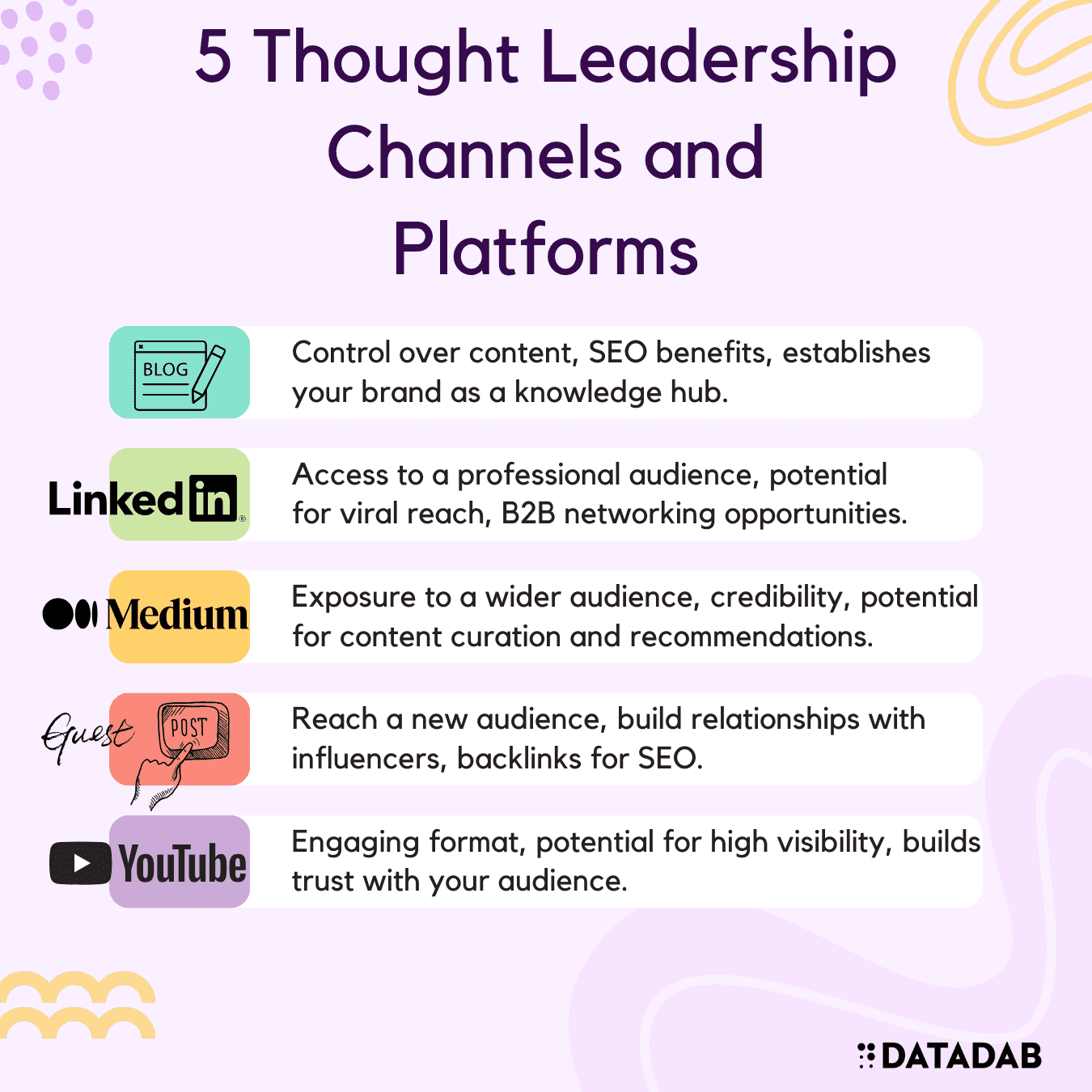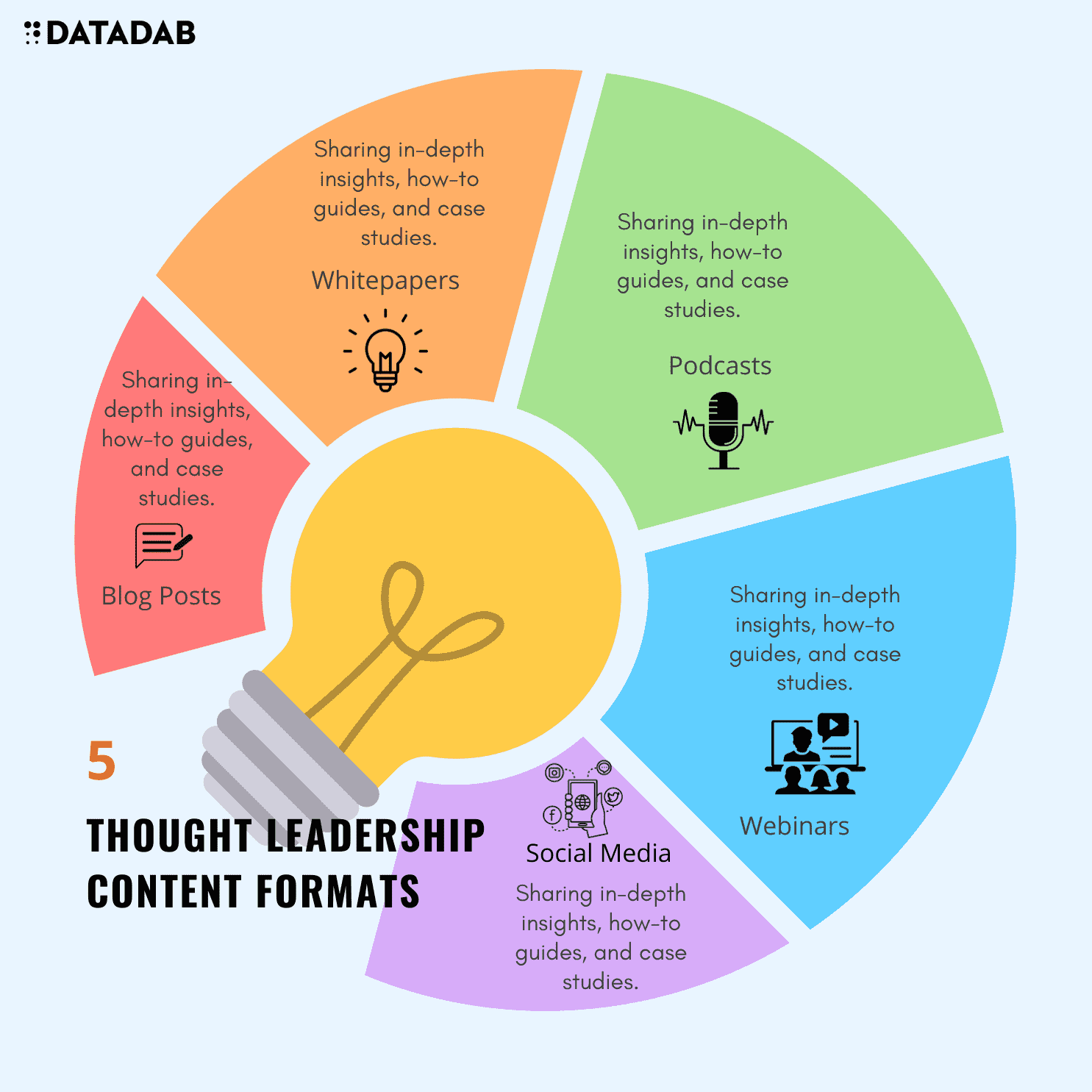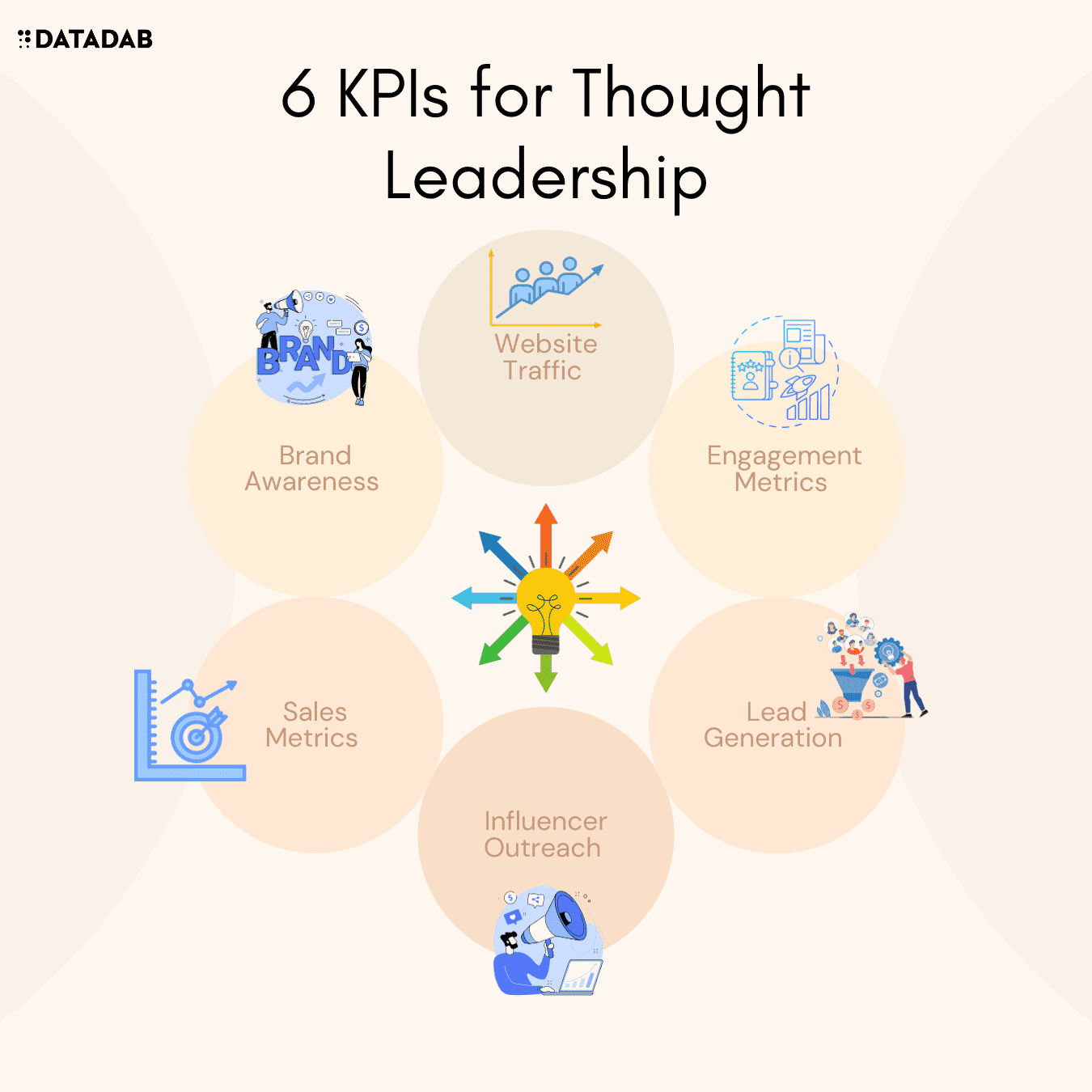"Thought leadership transcends traditional marketing; it's the investment in intellectual capital that pays dividends in brand loyalty."
Imagine standing in a room filled with people, each one of them talking about the same thing. They're all vying for attention, desperately trying to make their voices heard above the din. That's the state of the SaaS market today – brimming with competition, innovation, and noise. As a SaaS marketer, you're grappling with the Herculean task of cutting through this cacophony to reach your target audience and make them take notice.
So, how do you distinguish yourself from the rest and build that ever-elusive trust? The answer lies in thought leadership. It's not just a buzzword; it's a powerful tool that can build your brand and help you forge connections with your audience. In this article, we'll delve into the world of thought leadership in SaaS marketing. Together, we'll explore its importance, dissect the reasons why it's crucial for your business, and understand how to create a robust thought leadership strategy.
But, wait! We're not stopping there. We'll also uncover the best practices for SaaS thought leaders and learn how to measure the impact of your thought leadership efforts. By the end, you'll have a comprehensive understanding of thought leadership and how it can transform your SaaS marketing.
So, are you ready to embark on this journey? Grab a cup of coffee (or tea, if you prefer) and let's dive in!
Table of Contents
- What is Thought Leadership?
- Why is Thought Leadership Crucial for SaaS Marketing?
- Establishing Your Thought Leadership Strategy
- Best Practices for SaaS Thought Leaders
- Measuring the Impact of Your Thought Leadership Efforts
- Conclusion

What is Thought Leadership?
At its core, thought leadership is the act of establishing yourself or your organization as an expert in a specific field by sharing valuable insights and innovative ideas. It's not about promoting your product or service; instead, it's about showcasing your expertise, providing value to your audience, and building trust.
Thought leaders can be individuals or organizations, and they typically create and share content that demonstrates their deep understanding of a particular subject. This content can take the form of blog posts, whitepapers, podcasts, webinars, or even social media posts.

Why is Thought Leadership Crucial for SaaS Marketing?
In a crowded SaaS market, thought leadership can be the difference between success and failure. Here are some reasons why thought leadership is crucial for SaaS marketing:
1. Builds Trust and Credibility
Potential customers need to trust your brand before they invest in your product or service. Thought leadership helps build that trust by showcasing your expertise and providing valuable insights to your audience. By consistently delivering high-quality content, you establish your brand as a credible and reliable source of information in your field.
2. Differentiates Your Brand from Competitors
With so many SaaS companies vying for attention, it's essential to differentiate yourself from the competition. Thought leadership can help set your brand apart by positioning you as an innovative and forward-thinking expert in your industry. When potential customers view your brand as a thought leader, they're more likely to choose your product over a competitor's.
3. Drives Organic Traffic and Inbound Leads
By producing and sharing valuable content, you can attract organic traffic to your website and generate inbound leads. Thought leadership content can rank well on search engines, drawing in potential customers who are searching for information on topics related to your industry.
4. Enhances Your Sales Process
When you've established your brand as a thought leader, your sales team can leverage that reputation to close deals more effectively. Sales representatives can refer to your content during sales calls, demonstrating the depth of your expertise and instilling confidence in potential customers.
Thought Leadership Topic Brainstorming Worksheet
Use this worksheet to strategize impactful thought leadership topics that align with your niche, audience needs, and business goals.
Your Niche/Area of Expertise:
Your Audience:
- Key roles: ___________________________________
- Pain points: ___________________________________
- Interests: ___________________________________
Your Business Goals for Thought Leadership:
Brainstorm Potential Thought Leadership Topics:
- Recent industry trends/innovations: ___________________________________
- Common audience questions: ___________________________________
- Underserved audience needs: ___________________________________
- Hot debates/controversies: ___________________________________
- Research/data you can provide analysis on: ___________________________________
- Projects/case studies you can share insights from: ___________________________________
- Answers to key audience challenges: ___________________________________
- Predictions for industry future: ___________________________________
- Other ideas: ___________________________________
Now narrow down your brainstormed topics based on:
- Relevance to audience
- Alignment with your niche
- Ability to demonstrate your expertise
- Potential to attract links/shares
- Feasibility (access to info/data)
Your Top Thought Leadership Topic Ideas:
Establishing Your Thought Leadership Strategy
Creating a thought leadership strategy is essential to ensure consistency, quality, and relevance in your content. Here's how to establish a solid thought leadership strategy:
1. Define Your Niche
To stand out in the SaaS market, you need to specialize in a particular area. Identify your unique strengths and expertise and focus on a niche where you can provide the most value to your audience. This will help you stand out from the competition and make it easier for potential customers to recognize your authority.
2. Set Clear Objectives
Determine what you want to achieve through your thought leadership efforts. This could include increasing brand awareness, generating leads, or building relationships with industry influencers. By setting clear objectives, you can tailor your content strategy to meet your goals.
3. Create a Content Plan
Develop a comprehensive content plan that outlines the topics, formats, and channels you'll use to share your thought leadership content. Consider creating a content calendar to organize your content production and distribution. This will help ensure you maintain a consistent publishing schedule and keep your audience engaged.
4. Collaborate with Industry Experts
Engage with other thought leaders in your industry by collaborating on content, guest posting on each other's blogs, or participating in joint webinars. This not only expands your reach but also reinforces your status as an expert in your field.
5. Promote Your Content
To maximize the impact of your thought leadership content, promote it across multiple channels, including your website, social media, email, and industry publications. This will help increase your reach and improve the chances of your content being discovered by potential customers.
Thought Leadership Article Pitch Template
Use this template to create a compelling pitch when reaching out to publications with your ideas for contributed thought leadership articles.
Article Headline:
[Insert a compelling, benefit-focused headline that summarizes your article topic]
Opening Pitch Paragraph:
Dear [Editor's Name],
As a [your niche expertise], I wanted to pitch an article I believe would truly engage your audience of [target readership]. The working title is "[insert headline]" and it focuses on [summarize topic briefly in 1-2 sentences].
This article would be perfect for [Publication Name] because [explain why it aligns with publication's audience and topics]. I have extensive expertise in this area, including [summarize your experience/credentials in 2-3 bullet points].
Article Overview:
In a nutshell, this article will help readers:
- [Key benefit #1]
- [Key benefit #2]
- [Key benefit #3]
It will cover:
- [Summary of main points/sections in bullets]
I will share insights such as:
- [Brief expert perspectives, data points, case studies, or examples you'll provide]
This article is still highly relevant given [recent events/studies/news related to your topic if applicable]. I can have a draft ready by [realistic timeline for submitting the piece].
Please let me know if you would be interested in reviewing this article for potential publication. I'm happy to discuss the concept further and answer any questions you may have.
Thank you for your consideration,
[Your Name]
[Your Title/Position]
[Your Company]
Best Practices for SaaS Thought Leaders
To succeed as a SaaS thought leader, follow these best practices:
1. Provide Genuine Value
Always prioritize the needs of your audience and provide content that genuinely adds value. Avoid self-promotion and focus on sharing actionable insights that help your audience solve problems or make informed decisions.
2. Be Consistent
To build trust and credibility, you must consistently publish high-quality content. Establish a regular publishing schedule and stick to it, ensuring your audience has a steady stream of valuable information from your brand.
3. Stay Relevant
Keep up-to-date with industry trends and developments to ensure your content remains relevant and timely. Attend industry events, subscribe to relevant publications, and engage with other thought leaders to stay informed and maintain your expertise.
4. Be Authentic
Your audience can tell when you're being genuine, so avoid over-exaggerating your expertise or making false claims. Be honest about your strengths and limitations, and be open to learning from others in your field.
5. Measure and Optimize
Regularly assess the performance of your thought leadership content to identify areas for improvement. Use analytics tools to track engagement, conversions, and other key metrics, and use this data to optimize your content strategy.
Thought Leadership Topic Idea Generator
Answer these thought-provoking questions to come up with fresh, engaging ideas for your next thought leadership article:
- What are the latest innovations or advances in your industry?
- What trends are shaping your industry right now?
- What myths or misconceptions exist that you can debunk?
- What questions are your target customers frequently asking?
- What controversial issues or debates are happening in your space?
- What pain points can you help solve for your audience?
- What new research or data can you analyze and provide insight on?
- What case studies or projects can you share key takeaways from?
- What future predictions or forecasts can you make for your industry?
- What expert advice, tips, or strategies can you offer?
- What new applications are emerging for existing products/technology?
- What underserved audiences or use cases exist that you can address?
- What surprising insights or counterintuitive revelations can you uncover?
- What analogies, frameworks, or models can you create to explain complex topics?
- What limiting beliefs or outdated assumptions can you challenge?
Brainstorm ideas for articles that help establish your expertise and provide unique value for your audience based on these prompts!

Measuring the Impact of Your Thought Leadership Efforts
To ensure your thought leadership efforts are paying off, it's crucial to measure their impact. Here are some key performance indicators (KPIs) to track:
- Website Traffic: Monitor the number of visitors to your website, as well as the number of new and returning visitors. This can help you gauge the effectiveness of your content in attracting and retaining an audience.
- Engagement Metrics: Track metrics such as time on page, bounce rate, and social media shares to assess how well your content is resonating with your audience.
- Lead Generation: Measure the number of leads generated through your thought leadership content, including newsletter signups, content downloads, and webinar registrations. This can help you determine how effectively your content is driving conversions.
- Influencer Outreach: Keep track of the number and quality of connections you make with industry influencers, as these relationships can amplify your thought leadership efforts.
- Sales Metrics: Monitor the impact of your thought leadership content on your sales process, including lead-to-customer conversion rates and average deal size. This will help you understand how your content is influencing purchasing decisions.
- Brand Awareness: Assess your brand's visibility within your industry by tracking mentions, social media followers, and press coverage. This can help you gauge the success of your thought leadership efforts in raising your brand's profile.
Use these KPIs to evaluate your thought leadership strategy and make data-driven adjustments as needed to maximize its effectiveness.
Conclusion
In the crowded SaaS market, thought leadership is a powerful way to build authority and trust with your target audience. By establishing your brand as an expert in your field and consistently providing valuable, relevant content, you can differentiate yourself from competitors, drive organic traffic, and enhance your sales process.
To succeed as a SaaS thought leader, focus on defining your niche, setting clear objectives, and creating a comprehensive content plan. Collaborate with industry experts, promote your content, and adhere to best practices to ensure your thought leadership efforts resonate with your audience.
Finally, measure the impact of your thought leadership efforts using key performance indicators, and optimize your strategy based on data-driven insights. By embracing thought leadership in your SaaS marketing, you can build a loyal audience, increase brand awareness, and drive business growth in a competitive landscape.
FAQ
How does thought leadership differ from traditional content marketing?
Thought leadership is a specialized form of content marketing that focuses on establishing your brand as an authority within your industry. While traditional content marketing aims to attract, engage, and convert potential customers, thought leadership takes a more long-term approach, building trust and credibility with your audience through in-depth, valuable, and insightful content. It's less about promoting your products and more about showcasing your expertise, fostering relationships, and driving industry conversations.
Can thought leadership directly contribute to sales?
Yes, thought leadership can contribute to sales indirectly by building trust and credibility with your audience. When your target audience perceives you as an expert in your field, they are more likely to consider your products and services when making purchasing decisions. Additionally, thought leadership content can help attract and nurture leads, improve lead-to-customer conversion rates, and enhance your sales process by educating prospects and addressing their concerns.
How can I choose the right thought leadership niche for my SaaS company?
To select the right niche, consider your company's unique strengths, expertise, and value proposition. Analyze your target audience's pain points and challenges, and assess which topics and areas your company is best equipped to address. Research your competitors and identify gaps in the market where your company can offer unique insights and perspectives. Finally, consider the scalability and potential growth of the chosen niche to ensure long-term success.
Is it necessary to create thought leadership content in multiple formats?
While it's not strictly necessary to create content in multiple formats, doing so can help you reach a broader audience and cater to diverse learning preferences. By leveraging various formats, such as blog posts, podcasts, webinars, and social media, you can provide a more engaging and comprehensive experience for your audience. Experiment with different formats to determine which ones resonate the most with your target audience and align with your overall thought leadership strategy.
How do I promote my thought leadership content?
There are several ways to promote your thought leadership content, including:
- Sharing it on relevant social media platforms, such as LinkedIn and Twitter.
- Distributing it through email newsletters to your subscribers.
- Collaborating with industry influencers and peers to amplify your content's reach.
- Leveraging content syndication or guest posting opportunities on reputable industry websites.
- Optimizing your content for search engines to drive organic traffic.Remember, the key to successful promotion is consistency and engagement. Interact with your audience and continually share valuable content to build a loyal following.
How can I collaborate with industry experts to boost my thought leadership efforts?
Collaboration with industry experts can significantly amplify your thought leadership efforts by lending credibility to your content and expanding your reach. To collaborate with industry experts:
- Identify key influencers and thought leaders within your niche.
- Engage with their content by sharing, commenting, and providing valuable feedback.
- Reach out to them with a personalized message, explaining your mutual interests and proposing collaboration ideas.
- Offer guest posting opportunities, interviews, joint webinars, or co-authored research reports.Remember, successful collaborations are built on mutual respect and shared value, so focus on building genuine relationships with industry experts.
What are some common challenges in implementing a thought leadership strategy?
Some common challenges faced by SaaS companies in implementing a thought leadership strategy include:
- Defining a clear and focused niche.
- Producing high-quality, consistent, and engaging content.
- Attracting and retaining a loyal audience.
- Balancing thought leadership content with promotional content.
- Measuring the success of thought leadership efforts and adjusting the strategy as needed.
How can I ensure that my thought leadership content remains relevant and valuable over time?
To ensure that your thought leadership content remains relevant and valuable:
- Stay up-to-date with industry trends, news, and developments by following reputable sources and attending industry events.
- Regularly review and update your existing content to ensure it remains accurate, timely, and aligned with your audience's needs.
- Listen to your audience's feedback and incorporate their insights into your content creation process.
- Experiment with new content formats and topics to keep your content fresh and engaging.
- Periodically audit your content strategy to identify areas for improvement and refocus your efforts on providing maximum value to your audience.
How long does it take to see results from a thought leadership strategy?
Thought leadership is a long-term strategy that requires consistent effort, and the results may not be immediate. Depending on your niche, audience, and the quality of your content, it can take anywhere from a few months to a couple of years to see significant results from your thought leadership efforts. The key is to remain patient, consistently produce valuable content, and adjust your strategy based on data-driven insights and audience feedback.
Can small SaaS companies or startups effectively leverage thought leadership?
Absolutely! Thought leadership is not exclusive to large or established companies. In fact, small SaaS companies and startups can benefit significantly from thought leadership as it helps level the playing field with bigger competitors. By showcasing your unique expertise, insights, and solutions, you can build trust and credibility with your target audience, attract potential customers, and establish your brand as an authority in your niche. However, it's essential to invest time and effort in creating high-quality, valuable content and building genuine relationships with your audience to make your thought leadership strategy a success.






